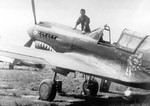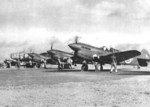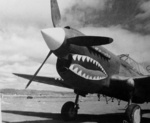P-40 Warhawk
| Country | United States |
| Manufacturer | Curtiss-Wright Corporation |
| Primary Role | Fighter |
| Maiden Flight | 14 October 1938 |
Contributor: C. Peter Chen
ww2dbaseIn Mar 1938, Curtiss-Wright designer Donovan Berlin approached the US Army Air Corps staff regarding a new fighter design in the Hawk series, and it immediately gained favor. In Jan 1939, when USAAC announced a competition for a new fighter aircraft, it was not surprising that Curtiss-Wright would emerge the winner. The first USAAC order for the new P-40 fighters was issued in Apr 1939; its size, 524 aircraft at the cost of US$13,000,000, was the largest contract issued to date. The P-40 design, internally named Hawk 81 at Curtiss-Wright, was similar to that of P-36 Hawk. They were relatively maneuverable at high speeds, but at lower speeds they were not up to par when compared with their contemporaries. Their top speed made them effective interceptors when they were initially introduced, but over time Curtiss-Wright engineers would frustratingly work countless hours attempting to increase their top speed to match their more modern competitors, especially the German fighters. Aircraft mechanics would later express appreciation for the Donovan Berlin's purposeful design that made maintenance simple; everything positions in front of the firewall could be changed by a skilled mechanic in 14 hours, for example.
ww2dbaseInterest soon came from France, and the Tomahawk variant was developed for the export market. While the French never took receipt of the Tomahawk fighters due to German occupation, Britain's order began rolling off production lines in Aug 1941; Britain would also take over the French contract for these fighters. By the end of Dec 1941, 10 fighters would be delivered to Britain, 72 to Canada, and 476 to Commonwealth squadrons in the Middle East (2 aircraft originally destined to the British forces were lost in transit). The first Tomahawk fighter to see combat belonged to the No. 112 Squadron of the British Royal Air Force over North Africa; they noted the Tomahawk fighters' ability to absorb battle damage. On 29 Aug 1941, Australian pilot Clive Caldwell was engaged by two German Bf 109 fighters, including one piloted by hit by ace Werner Schroer; Caldwell downed Schroer and forced Schroer to disengage by heavily damaging his fighter, then made it safely back to base with damage from over 100 7.9mm bullets and five 20mm cannon shells. Later in the war, the Soviet also received some fighters of this design (247 examples of Tomahawk aircraft and 2,178 examples of P-40E, P-40K, P-40L, P-40M, and P-40N aircraft); initially they were delivered by ship to northwestern Russian ports such as Murmansk, but later on some were delivered via Persia while a few were delivered by flying them from US Territory of Alaska to the Siberia region of Russia. Three among the two-time Hero of the Soviet Union were Tomahawk/P-40 pilots.
ww2dbaseWhile the USAAC received its first P-40 fighter in Mar 1940, the first American to see combat in the cockpit of a P-40 fighter was not an active duty serviceman. That honor went to the pilots of the American Volunteer Group fighting alongside the Nationalist Chinese forces against Japan. They were initially equipped with 100 P-40 fighters originally built for Britain (special negotiations were conducted so that Britain would receive 100 later model fighters in exchange). These fighters, characteristically painted with shark mouth markings (although Luftwaffe Me 110 Zerstörer units were credited as being the first to use the shark mouth design, while No. 112 Squadron RAF made such design popular within the Allies), were among the most memorable in military aviation history. The durable P-40 fighters of the AVG "Flying Tigers" were a good match for the more maneuverable but less-armed Japanese Army fighters deployed in China. AVG pilots flying P-40 fighters shot down 115 Japanese fighters (some estimates were as high as 297) in China at the cost of 21 losses prior to the official entry into WW2.
ww2dbaseIn Jan 1942, Merlin engines began appearing in P-40 fighters, and these new "F" variants were the first to be given the nickname Warhawk. While 1,131 P-40F Warhawk fighters were built, the most numerous variant would be the later P-40N (known as Kittyhawk IV to the RAF), 5,215 of which would be built between Mar 1943 and Nov 1944. By that time, however, US Army Air Forces were already ordering more capable fighters from Curtiss-Wright's competitors, and the upgraded P-40Q variant design came too late to change the mind of USAAF leaders. Thus, production ceased on 30 Nov 1944 after 13,736 fighters were built. They would remain in front line service until the end of WW2, however. "If you flew wisely, the P-40 was a very capable aircraft", said American ace Robert Marshall DeHaven.
ww2dbaseSources:
Carl Moleworth, Curtiss P-40: Snub-nosed Kittyhawks and Warhawks
Carl Molesworth, P-40 Warhawk vs Ki-43 Oscar
Wikipedia
Last Major Revision: Jun 2008
P-40 Warhawk Timeline
| 3 Mar 1938 | Curtiss-Wright designer Donovan Berlin presented his Hawk 81 design to leaders of the US Army Air Corps. |
| 26 Apr 1939 | The US Army Air Corps placed an order for 524 P-40 fighters; it was the largest contract to date at the value of US$13,000,000. |
| 27 Apr 1939 | The British Air Ministry awarded the largest-ever order for a US-built fighter aircraft with an order for 524 Tomahawk fighters. |
| 22 May 1941 | The first flight of the Curtiss Hawk 81 fighters, known as Kittyhawk I to the British and P-40D to the Americans, was ordered by both the British Royal Air Force and the US Army. |
| 1 Jan 1942 | Kittyhawk fighters saw combat in North Africa for the first time, with 9 No. 3 Squadron RAF Kittyhawk fighters attacking 16 German Ju 87 Stuka dive bombers escorted by 6 Bf 109 fighters. The British Kittyhawk fighters would shoot down four Ju 87 and one Bf 109 aircraft. |
| 25 Jan 1942 | 13 P-40E fighters of US 17th Pursuit Squadron (Provisional) arrived at Soerabaja, Java, Dutch East Indies. |
| 5 Feb 1942 | 120 P-40 fighters arrived at Brisbane, Australia from the United States. |
| 1 Mar 1942 | The first four of No. 75 Squadron RAAF's Kittyhawk fighters arrived at Port Moresby, Australian Papua. Two of them would see combat later on the same day, with Flight Officer Barry Cox and Flight Officer Wilbur Wackett shooting down one Ki-21 bomber flying a reconnaissance mission over Port Moresby. |
| 8 Mar 1942 | The first batch of Kittyhawk fighters were transferred to the Royal Australian Air Force in Australia. No. 75 Squadron RAAF would be first to receive these aircraft, while No. 76 Squadron and No. 77 Squadron would be similarly equipped in the following few days. |
| 8 Apr 1942 | The P-40E fighter saw its first combat and first victory in Asia as Flight Leader Robert Little of 1st Pursuit Squadron shot down a Ki-43 aircraft over Leiyun (Loiwing), Yunnan Province, China. |
| 12 Apr 1942 | Lieutenant John Brownewell of US 17th Pursuit Squadron, flying a P-40 fighter, scored the 37th and final confirmed victory by a P-40 fighter over the Philippines. The victory was achieved near Del Monte Airfield in northern Mindanao, Philippine Islands. |
| 16 May 1942 | The first operational use of "Kittybombers" in the western desert (P-40 Kittyhawk fighters equipped with a bomb rack for a 500-lb bomb) occured when six aircraft of No. 112 squadron RAF attacked an enemy camp east of the main road near Bomba, Libya. |
| 16 May 1942 | No. 112 Squadron RAAF was declared operational in North Africa. It would the Allied Desert Air Force's first Kittybomber unit. |
| 6 Jun 1942 | In Libya, Kittybombers repeatedly attacked Axis armor formations near the Knightsbridge box during the Battle of Gazala. |
| 4 Jul 1942 | The American Volunteer Group of the China Air Force was disbanded. Its P-40E and Tomahawk fighters were transferred to USAAF 23rd Fighter Group, which was the AVG's successor. |
| 7 Apr 1944 | No. 112 Squadron RAF, flying Kittyhawk fighters, shot down a German aircraft over Rieti Airfield in Italy; this would be the final Kittyhawk victory in the Mediterranean theater of WW2. |
| 10 Jun 1944 | Kittyhawk fighters of No. 80 Squadron RAAF shot down a Japanese Ki-61 aircraft over New Guinea island. This was the last Commonwealth Kittyhawk fighter victory of the war. |
| 22 Nov 1944 | The 15,000th P-40 fighter was built at the Curtiss-Wright factory in Buffalo, New York, United States. |
| 30 Nov 1944 | Production of P-40 fighters ceased. |
| 29 Jan 1945 | The last WW2 P-40 fighter victory against a Japanese aircraft was recorded. |
SPECIFICATIONS
P-40E
| Machinery | One Allison V-1710-39 liquid-cooled V-12 engine rated at 1,150hp |
| Armament | 6x12.7 Browning M2 machine guns, optional 680kg bombs |
| Crew | 1 |
| Span | 11.38 m |
| Length | 9.66 m |
| Height | 3.76 m |
| Wing Area | 21.92 m² |
| Weight, Empty | 2,880 kg |
| Weight, Loaded | 3,760 kg |
| Weight, Maximum | 4,000 kg |
| Speed, Maximum | 580 km/h |
| Speed, Cruising | 435 km/h |
| Rate of Climb | 11.00 m/s |
| Service Ceiling | 8,840 m |
| Range, Normal | 1,050 km |
Photographs
 |  |  |  |
Did you enjoy this article or find this article helpful? If so, please consider supporting us on Patreon. Even $1 per month will go a long way! Thank you. Share this article with your friends: Stay updated with WW2DB: |
Visitor Submitted Comments
13 Feb 2007 08:52:15 PM
Thank you for the site. My Mom worked here during WWII as a welder.
23 Aug 2008 02:33:59 AM
It's been down-played as inferior. It was really a potent machine, and for several reasons supreme. It was really THE thing you probably wanted to BE in if you had just one choice of what you had to go up there in (that lethal environment). It was like driving a 1970's solid-steel bodied Ford Mustang Mach 3 with a 500 cubic inch V-8, when everything else was a Fiat Spyder. Most of the P-40s weighed in the neighborhood of 10,000lbs. fully loaded and equipped, without any bombs or droptank. That's FIVE TONS of steel. Going 350+ mph through the air CONTINOUSLY and CONSTANTLY. It had a "vicious stall characteristic", and was "totally unforgiving". Testimony said it was "scary" and "frightening". There was only one way to fly the thing - fast. ALL THE TIME. If you didn't it would fall out the sky like a boulder. It was HEAVILY armored (the plane was just filled with armor) with a five-spar wing with self-sealing tanks. It was heavily armed. It was simple and uncomplicated. All models went 350+ in LEVEL flight. Scary. It was simply an airplane to be avoided - incredibly dangerous machine. The P-40 wasn't a fancy aerobatic flyer. It was a "war"plane in utter spartan simplicity and nothing else. It was a flying armored vehicle - even worse (for the opposition, that is) - it was like a flying artillery shell that was armed and directed by a pilot. It was only 37'4 by 31'2 yet it weighed FIVE TONS. It was simply an airplane to be avoided.
9 Jul 2010 12:36:31 PM
The Curtiss P-40 was the third largest in
number sent to the Russians during WWII.
The other two fighters were the Airacobera and Hurricane.
Some of the early model P-40's were sent by the British who were phasing them out, and
longer being used by them in Europe.
The Soviet air force was suffering heavy losses and accepted any fighter they could get.
Some of the early shipments from the U.S.A.
were by ship, on a cash and carry basis the fighters were paid for with gold, platinum
and other goods of value. By 1942 the P-40's
started to be ferried from Alaska to the
U.S.S.R. The Russians used the P-40 as a
fighter, ground attack, reconnaissance and
whatever mission the Russians could use the P-40 to hit back at the Germans.
Russian naval aviation also used the P-40
for air cover of supply convoys, and other
attacks against the Germans.
After the war, the P-40's were retired from
front line service. Some of the surviving
fighters, were used as trainers and served
until the late 1940's.
10 Jul 2010 05:15:09 PM
"THE RUSSIANS ARE COMING
THE RUSSIANS ARE COMING"...
Ladd field was a staging area for lend-lease
aircraft being supplied to the USSR.
The first Russian ferry pilots arrived in 1942, Ladd field was divided into two areas
the Russians used one-half of the field, the
US other half. A detachment of 300 Russians
were stationed, barracks, hangers and other maintanence and supply shops were built.
US pilots flew lend-lease aircraft from
Great Falls Montana through Canada to Ladd field.
The Russians would check out all the aircraft
test fly them and leave Ladd for Fairbanks via Galena that was used as an emergency and intermedite airfield, and on to Nome, to
Siberia and to European Russia.
The USA supplied over 18,763 aircraft to the
USSR, 8,000 were flown from Alaska.
Did you know...
Ladd field was named after Major Arthur Ladd,
U.S Army Air Corps who was killed in a 1935
air crash.
Forty Nations received lend-lease equipment
during World War II.
Cost: Between Forty Two (42) and Fifty (50)
Billion Dollars!
Aircraft delivered:
Curtiss P-40
Bell P-39 Aircobera
Bell P-63 Kingcobera
Republic P-47
North American B-25
Douglas A-20
Plus a number of transports and trainers.
*Note
Politicians talk about Billions and now even
Trillions what does it mean.
Take One Trillion, One Dollar Bills, Stack
them they would reach (67) Sixty Seven Miles
High!
11 Jul 2010 10:33:18 AM
Lend-Lease to the Russians:
Metals
Chemicals
Petroleum
Machinery
Food & Clothing
Textiles & Dyes
Rubber Products
Communication Equipment
Miscellaneous Supplies & Material
Railroad Rolling Stock & Locomotives
The Allies also sent: 350,000 Trucks,78,000 Jeeps and 22,000 Aircraft, this is about 10%
of the USSR's War Production.
Plus Weapons, Spare-Parts and Ammunition.
And over Two Billion Cans of Spam!!...
The Allied Aid was supplement to the Russians
own massive war production, still the
Capitalist goods helped push the German
Wehrmacht back towards Berlin.
26 Jan 2011 08:48:42 AM
In an attempt to improve the P-40’s altitude performance a Packard-built supercharged Rolls Royce Merlin 28 engine was fitted to a P-40D airframe and flown for the first time on November 25, 1941. Merlin powered P-40s were given the designation P-40F but due to engine delivery problems only 1,311 would be built (the Allison engine being reintroduced in later models).
250 P-40Fs were purchased with Lend-Lease funds for the RAF (as the Kittyhawk II) but in the event, the RAF did nor receive any of this version as 100 were transferred to the Soviet Union, some were lost at sea, others went to the Free French and the remainder were retained by the USAAF.
8 Jun 2013 12:16:37 PM
The P-40's level-flight and dive-flight manueverability was excellent. It is widely confirmed by pilot testimony (including that of famous ww2 veterans)that though it had mediocre climb performance, in all other flight attitudes and handling it was "crisp and agile".
It was more manueverable than the P38, P47, Bf109, F190, Hurricane, a host of later British fighters, and, even on par with the P51 at low and mid-level altitude! It was unmatched in a dive to the deck, and was formidable being flown around at terminal velocity inside the low altitude box. If a pilot knew how to fly it, as did Clive Caldwell, it could hold it's own with any propeller aircraft of WW2.
2 Sep 2017 11:41:45 AM
I believe your statement that:
"While the USAAC received its first P-40 fighter in Mar 1940, the first American to see combat in the cockpit of a P-40 fighter was not an active duty serviceman. That honor went to the pilots of the American Volunteer Group fighting alongside the Nationalist Chinese forces against Japan." is incorrect. The first Americans to see combat in a P-40 were active duty servicemen. It happened during the attack on Pearl Harbor - 7 Dec, 1941 - when P-40s engaged attacking Japanese aircraft. The first combat missions of the AVG (Flying Tigers) didn't take place until weeks later on 20 Dec, 1941...
8 Dec 2019 01:47:33 PM
I'm doing some research on the P40 and trying to obtain the information on as many manufacturers on parts for the plane, as I can find. How would I find this info? Thanks, Jess
All visitor submitted comments are opinions of those making the submissions and do not reflect views of WW2DB.
» Operation Ichigo
Related Books:
» Curtiss P-40
» P-40 Warhawk vs Ki-43 Oscar
- » 1,150 biographies
- » 337 events
- » 43,917 timeline entries
- » 1,241 ships
- » 350 aircraft models
- » 207 vehicle models
- » 374 weapon models
- » 123 historical documents
- » 260 facilities
- » 470 book reviews
- » 28,542 photos
- » 432 maps
Winston Churchill, 1935
Please consider supporting us on Patreon. Even $1 a month will go a long way. Thank you!
Or, please support us by purchasing some WW2DB merchandise at TeeSpring, Thank you!
30 Jan 2007 06:42:12 PM
Peter, I have the original copy of the Warhawk in T.L.Books World at War. The one with the sharks teeth it is framed in black tape with some clear material over the pic.